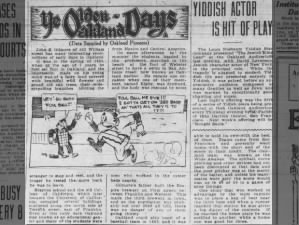College of California, Baseball, Beer - Ye Olden Oakland Days - Oakland Tribune - 25 Jul 1920, Sun - Page 8
 Remembrances of John S. Gilmore, 1860s, university, brewery, baseball
Ye Olden Oakland Days
TO BLOG Sun, Jul 25, 1920 – Page 8 · Oakland Tribune (Oakland, California) · Newspapers.com
Remembrances of John S. Gilmore, 1860s, university, brewery, baseball
Ye Olden Oakland Days
TO BLOG Sun, Jul 25, 1920 – Page 8 · Oakland Tribune (Oakland, California) · Newspapers.comJohn S. Gilmore of 562 William street has many interesting recollections of early days in Oakland.
It was in the spring of 1863, when at the age of 7 years, he first set foot in Oakland, and the impression made on his young mind was of a fairy land covered with beautiful wild flowers and grand old oak trees, their wide-spreading branches inviting the stranger to stop and rest, and the longer he rested the more loath he was to leave.
Brayton school and the old College of California, which later became the University of California, occupied several buildings scattered along the north side of Twelfth street, east of Franklin. Even at this early date Oakland was known as an educational center and many of the students were from Mexico and Central America.
On warm afternoons in the summer the students, headed by the professors, marched to the beach at the foot of Webster street to have a swim in San Antonio creek, now known as Oakland harbor. He recalls one occasion when one of their members, named Rigby, was drowned, and the body was rescued by some men who worked in the oyster beds nearby.
Gilmore's father built the Empire brewery on First street between Franklin and Webster. This made the third brewery in town, and as the population was probably not over 3000 all told, there was no danger of any of them going thirsty.
Oakland could also boast of a baseball team in 1863, and it was able to hold its own with the best of them. Teams came from San Francisco and generally went home with the short end of the score to their credit. The. Oakland team was known as the Wide Awakes. The spitball, curve pitching and other devices had not been discovered at that date and the poor pitcher was at the mercy of the batter, and unless his teammates were spry the score would run up to 40 or 50 in a game of nine innings.
One stunt that was worked to advantage by the team captain was to place a keg of beer near the third base and when a runner reached that station he was given a big dipper of the contents. If he reached the home plate he was entitled to another, while a home run was good for three.


Comments
Post a Comment